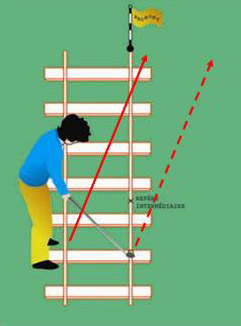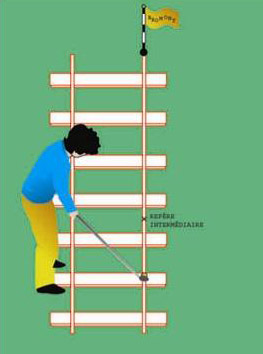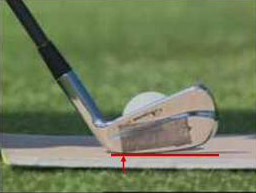 People remember when they had that first “I gotta do golf!” moment. Maybe you were watching golf on TV a couple of weeks ago, and saw the crowd go wild when Ernie Els birdied the 17th at Doral to clinch the CA Championship. Maybe your in-laws gave you a set of irons for your first wedding anniversary.
People remember when they had that first “I gotta do golf!” moment. Maybe you were watching golf on TV a couple of weeks ago, and saw the crowd go wild when Ernie Els birdied the 17th at Doral to clinch the CA Championship. Maybe your in-laws gave you a set of irons for your first wedding anniversary.
Once you say yes, the next few weeks can be mind-boggling. People are talking about fairway metals, short irons, up and down, wedge bounce, and other weird things. And, beginners quickly realize how ominous the first tee can be: You have to hit a pesky little white ball while dozens of people watch. How does Ernie do it?
Fear not, golf is quite do-able and fun if you just know the secrets for getting started. Here are five basics I wish people had shared with me when I was a beginner.
Number Five: Take Some Lessons
Golf appears to be complicated to beginners because of all the noise surrounding it. Driver, cut shot, hybrid, lag putt, and other buzzwords. Well, one way to cut through the noise is take some lessons.
Granted, your friends can show you the basics. But, friends vary in their skills. One friend may be former college golfer who shoot close to par, and quickly gets impatient with you. Or the friend can be… errr… a movement-challenged soul who rarely breaks 100. So, golf goes better if you take some lessons from a knowledgeable teacher at the beginning.
Lessons give you a systematic approach to learning the swing. Key topics include:
- Grip: How you hold the golf club is critical. Two very popular grips are the interlocking and the overlapping, which the pro or instructor can explain to you. Pros can suggest variations on the grip once they see how you naturally hit the ball. Key thing: You want the proper grip to be automatic, so you can think about other things while you line up the shot.
- Stance: Standing properly with good posture is critical for being able to swing the golf club with purpose. While there are some basic rules on this, each person will vary the rules somewhat depending on height, arm length, etc.
- Alignment: Know how to line up on target. Tips on this are in the next item.
- Swing Motion: The swing motion requires balance and control of power. Basic rule: Swing the club and let the club hit the ball. A smooth swing with control produces much more than hitting with every ounce of strength you have.
Number Four: Know How to Line Up
How you align your body toward the target is critical. Golf instructors suffer a lot of pain when they face students who constantly miss to the right. Often this is caused by faulty alignment.


In a concept known as railroad tracks, golfers must align both their clubface-swing path and their feet in parallel lines. The diagram on the left gives the basic idea. These parallel lines are roughly 18 inches apart. The brown lines show the proper alignment of the two paths.
In the image on the right (above), the red arrows show an error that beginners and struggling golfers often make: They line up their feet to the target, rather than their clubface. This angles their swing plane – and the likely path of the ball – to the right of the target. So, even if they hit the ball squarely, they miss the target well to the right. Adding to the problem is an optical illusion caused by looking sideways toward the hole: an inexperienced golfer thinks he’s on target, when he’s actually lined up to the right.
Here’s a website which gives details on how to develop proper alignment.
Number Three: Go Basic on Clubs
You can gather your mix of clubs in several ways. Often, the person giving you lessons can help you on this. And you should get a basic, static fitting for the clubs. The static fitting involves making sure the clubs fit you in terms of shaft flex, shaft length, and club lie. Club lie involves how upright or flat the club lies on the ground. A person who is taller, or has shorter arms, might need a more upright lie. A person who is shorter, or has longer arms, may need a flatter lie.
 Once you get more experience and your swing stabilizes, you might consider a dynamic fitting which involves detailed computer analysis. For beginners, however, dynamic fitting is a waste of money, since their swings still vary widely from day to day.
Once you get more experience and your swing stabilizes, you might consider a dynamic fitting which involves detailed computer analysis. For beginners, however, dynamic fitting is a waste of money, since their swings still vary widely from day to day.
For selecting clubs, you also have options:
- Boxed sets. You get a set of matching clubs and a golf bag which come together in a box. Many boxed-set models can be adjusted for individuals following a static fitting. Cost can range from $200 to $500. See an earlier Bag Drop article on this.
- Used clubs. Golf shops often give trade-in money for older sets of clubs when people buy a brand new set. The shops need to turn these trade-ins around quickly to get their money back and clear shelf space. If a used set fits your build and needs, this might be a way to go. This, of course, requires some club knowledge to make sure an assortment of irons, woods and hybrids fits your needs. Getting advice from a pro or a skilled clubfitter for really help here.
- New clubs. Some people want upscale clubs from the start. If you need fancier clubs for business reasons, so be it. But, this can cost you a couple of thousand dollars for clubs which might not fit you for the long run. The advantage, of course, is that such clubs would have higher trade-in value.
Besides a source of clubs, you need to decide how many you really need. You can have up to 14 clubs in your bag, but beginners don’t really need that many. For men, you can get started with irons five through Pitching Wedge, a sand wedge, a driver and a 3 wood, a hybrid and a putter – 11 clubs. Women’s starter sets sometimes have fewer clubs, and may have an extra hybrid in place of a 5-iron. Eleven clubs will be plenty to learn to use during Year One.
Number Two: Learn to Chip and Putt (and Hit Fairways off the Tee)
Golf has become big on statistics in the last 50 years, including the one that roughly 70 percent of shots take place within 120 yards of the green. So, you can really help your early scores if you can chip, pitch, and putt.
I’ll keep it short on chipping and putting, since everyone will emphasize this once you declare an interest in golf. But, an overlooked companion point for beginners is the second part of this secret: find the fairway. When you’re on the tee, get your ball into the fairway. You don’t have to blast your drive 300 yards. In fact, beginners need to realize that drivers can be difficult to hit. On days when the driver misbehaves, go with a 3-wood or even a hybrid off the tee.
Golf gets to be very frustrating if your tee shots always end up in the trees, or dribble 20 yards and stop. And, it can make bogies difficult to salvage.
Number One: Bogeys are Good
The first year of golf can be a roller coaster ride from exhilaration to despair, often on a hole-to-hole basis. If you have trouble with Number Two, and fail to hit the fairway, don’t make matters worse by following a bad shot with a dumb shot. If you’re in shaggy rough, try to get back to the fairway. Maybe take an 8-iron iron and get it into the sunshine. Then, you can wedge or chip your way onto the green.
If the rough is less shaggy, take a hybrid and knock it up toward the green. If the green is open, maybe you can bounce it up on the putting surface. But if there’s trouble around the green – a creek in front, or maybe deep bunkers left and right – lay up short of the trouble. Things will work out better if you’re hitting a wedge or chip shot from in front of the green, rather than hitting out of a chest-deep bunker or fishing your ball out of the water.
If it’s a really long hole – perhaps a par five – you might take a 3-wood off the tee and stay short of any trouble. Then, lay up to a level spot short of the green where you can hit a short iron toward the flag. (This also works on long, tough par fours.)
On shorter holes, if you hit the fairway, you can be more aggressive and possibly make a par. And, when coming out of trouble wisely, you can save par sometimes with an up and down. But if things get tough, keep your head and find a way to salvage bogie.
Closing Remarks
So, these five secrets will help you get started in golf. First of all, take some lessons. If you self-teach like I did, you risk spending years trying to undo bad habits. Learn how to line up your shots, and learn to handle the optical illusion caused by glancing sideways during alignment. As for clubs, get some that fit and learn to use them. Learn to chip and putt – and to get your tee shot into the fairway. Again, if your driver isn’t working, shift to the 3-wood or a hybrid. And finally, bogies are good – sometimes a bogie will win against the more experienced golfers who gamble and fail.
This is enough to get you started. In a couple of weeks, you will learn five things beginning golfers should not do. More later!
This article was written by John P. Orr, better known as WUTiger in the forum.

Good read, I wish this was around 10 years ago…
I think all the points are good, but I would add:
#3) I think used premium clubs 1 or 2 generations old are the best buys, IMHO.
#2a) For the real beginner, take a lesson on chipping, pitching, putting and getting out of a bunker.
#2b) Practice what you learned in 2a.
I definitely endorse the focus on hitting fairways over the focus on hitting for distance. Beginners have a hard enough time hitting from the fairway so it just adds insult to injury to have to hit the second shot from the rough.
Great read.
I started playing almost a year ago and did #’s 1, 2, and 3. I’m glad I did.
#3-Started with a basic boxed set of Acuity Clubs(1W, 3W, 5W, P, 4i-PW)
#2-One of the first things I started to work on. I was always going up to the chipping and putting green and working on my short game.
#1-From the start I tried to just bogey every hole. I made bogey my par in a sense.
Great article, I would just add getting out and playing pitch-and-putt and executive courses. I was scratch at pitch n putt before I went to a full length golf course. First time out I broke a 100 because I could down in 3 or 4 from 150 yards.
Ralph
This may sound a little too advanced for a beginner, but I would still tell said learner, hit the ball first with a flat left wrist and learn this with the shorter clubs first. Don’t worry too much about how you get there yet. Look at as many videos and pictures of good swings as you can.
Good stuff … wish I had read this several years ago!
Ralph,
Good point on the pitch and putt and executive courses. Full length par 3 layouts are good too.
In my past ventures of teaching golf without a license, I would take the beginner out to the range twice – chipping/putting | then full shots. Third time we’d go to a par 3 layout. As you noted, the emphasis was on scoring rather than worrying about driver distance.
Thank you . Great article. Wish you had written it when I started golf all those years ago.
May I just add – Pretend you don’t see any water. For whatever reasons, beginners then to be “attracted” to the water even though it really shouldn’t be “in play”. LOL
Me too, wish I have read this book years ago too…this would have helped me i’m sure.
A book that has helped me recently improve my golf swing in a totally different way is a book called “Straight Down the Middle” by Josh Karp.
I learned to hit the ball with my eyes closed, standing on one foot… It’s really an interesting approach that should be tried. I wanted to get another book for my dad for Fathers Day coming up soon and noticed this hit the #1 best sellers list so I think it’s going to be a popular one soon!
Make contact. The only swing thought a beginner should have is make contact. Tinkering comes well after the contact issue is second nature. When I’m out of whack, I go back to just trying to make contact.
I would add, leave the long clubs alone and hit what you hit well. To many times I see beginners hitting driver, three iron and the like when the are scheduled to, only they can’t hit them at all. A 300 yard whole is two 8 irons or a driver and a sand wedge, same strokes to get there.
lastly, know your game. you can’t hit it 300 yards, to play ready golf and hit when you can. Don’t think that that 400th shot might be gold and hit the group in front, if it does, they’ll understand. Play within your actual game, not your dream game. And for the love of golf, learn the etiquette!
one problem is see is that the catch-phrase, “chicks dig the long ball” plus the proverbial male ego quickly gets in the way of real progress. if the golfer wishes to get serious, sign up for weekly lessons. tell the pro your goals. if the passion takes hold, he will learn the game from the green back to the tee box as you suggest.
From TeeItUp…
” …Too many times I see beginners hitting driver, three iron and the like when the are scheduled to, only they can’t hit them at all. A 300 yard whole is two 8 irons or a driver and a sand wedge, same strokes to get there. …”
This goes for more than beginners. When I play scrambles, I’m the one who hits the 5-iron off the tee on the 320 yd. par 4. Then, after my partners put their drivers OB or into the trees, we end up hitting my ball out of the fairway.